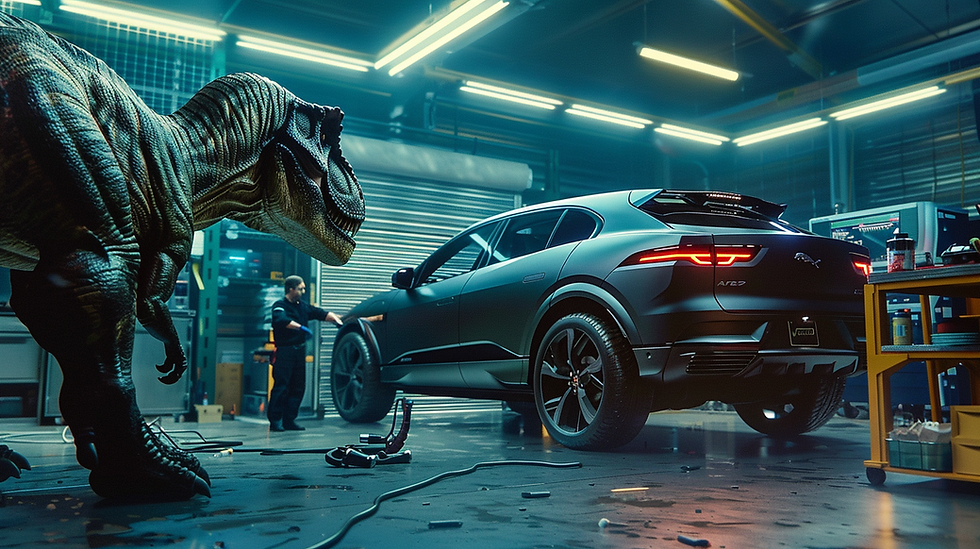The Collision Industry: Stuck in the Dinosaur Era?
- Elie L
- Jul 30, 2024
- 4 min read
Updated: Mar 20
A Glimpse into the Past
The collision repair industry, vital for restoring vehicles to their pre-accident condition, has remained relatively unchanged for decades. While other sectors have embraced technological advancements, automation, and artificial intelligence (AI), collision repair shops often seem to be stuck in a bygone era. This article explores why the industry lags in adopting modern technologies and how embracing innovation could transform it.
The Current State of the Collision Industry
Manual Processes:
Estimations and Triage: Many collision repair shops still rely on manual inspections and Total Loss Triage. Technicians visually assess the damage and manually enter data into outdated systems, leading to inefficiencies and potential errors.
Communication and Documentation: Communication with customers and insurance companies often involves phone calls, emails, and paper documents. This process is time-consuming and prone to miscommunication.
Limited or no Automation:
Repair Workflow: The repair workflow in many shops lacks automation. From ordering parts to tracking repair progress, many steps are handled manually, slowing down the process and increasing the likelihood of mistakes.
Quality Control: Ensuring consistent repair quality relies heavily on individual technicians' expertise, with limited automated quality control checks in place.
Lack of Data Integration:
Siloed Systems: Data is often siloed in different systems, making it difficult to get a holistic view of the repair process. Integration between shop management software, customer relationship management (CRM) tools, and parts ordering systems is often lacking.
Manual Data Entry: The lack of integration often requires manual data entry, which is time-consuming and prone to human error. This not only slows down the repair process but also increases the likelihood of mistakes that can lead to further inefficiencies and customer dissatisfaction.
Statistics Highlighting Industry Challenges
Market Size: The global automotive collision repair market was valued at approximately USD 199.56 billion in 2023 and is anticipated to grow at a compound annual growth rate (CAGR) of 1.9% from 2024 to 2030.
Canadian Market: In Canada, the collision repair market was estimated at CAD 6.8 billion in 2021, with approximately 6,390 body shops across the country. However, only 28.4% of these shops are under a banner program, highlighting a fragmented market.
Labor Shortages: The industry faces a significant talent gap, with many experienced technicians retiring and fewer entry-level technicians entering the field. This shortage hampers the speed and quality of repairs and puts immense pressure on existing employees.
The Potential of Modern Technology
Artificial Intelligence and Machine Learning:
Damage Detection and Estimation: AI-powered tools can automatically detect damage and generate repair estimates with high accuracy. This reduces the time needed for inspections and improves estimate accuracy.
Predictive Maintenance: AI can analyze data from previous repairs to predict which parts are likely to need replacement, streamlining the parts ordering process and reducing delays. Studies suggest that AI can reduce repair times by up to 30% and improve accuracy significantly.
Automation:
Workflow Automation: Automating routine tasks, such as parts ordering, repair progress tracking, and quality control checks, can significantly improve efficiency and reduce human error.
Customer Communication: Automated systems can keep customers informed about the status of their repairs through real-time updates and notifications, enhancing customer satisfaction.
Data Integration and Analytics:
Integrated Systems: Integrating various systems within the repair shop can provide a comprehensive view of operations, helping shop owners make data-driven decisions.
Performance Analytics: Analyzing repair data can identify bottlenecks in the workflow, highlight areas for improvement, and track key performance indicators (KPIs).
The Way Forward
To move out of the "dinosaur era" and embrace the future, the collision repair industry must overcome its resistance to change and invest in modern technologies. Here are some steps to get started:
Educate and Train:
Workforce Development: Invest in training programs to upskill technicians and staff, preparing them to work with advanced tools and systems.
Industry Collaboration: Partner with technology providers, industry associations, and educational institutions to develop comprehensive training programs.
Invest in Technology:
Pilot Programs: Start with pilot programs to test new technologies on a small scale. This can help demonstrate the benefits and build confidence among shop owners and technicians.
Financial Support: Explore financing options, grants, and incentives that can help offset the initial investment costs.
Foster a Culture of Innovation:
Leadership Commitment: Shop owners and managers must lead by example, showing a commitment to embracing new technologies and fostering a culture of continuous improvement.
Customer-Centric Approach: Focus on the customer experience. Implementing technology that enhances communication and transparency can build customer trust and loyalty.
Conclusion
The collision repair industry has the potential to undergo a significant transformation by embracing modern technologies, automation, and AI. While the path forward may present challenges, the benefits of increased efficiency, improved accuracy, and enhanced customer satisfaction make it a worthwhile endeavor. By moving out of the "dinosaur era" and into the future, the industry can not only survive but thrive in an increasingly digital world.
Trueclaim: Pioneering the Future of Collision Repair
Trueclaim is at the forefront of this promising future, offering innovative AI solutions that address the industry's most pressing challenges. By integrating advanced damage detection, automated estimation creation, and seamless data integration, Trueclaim empowers collision repair shops to achieve unprecedented levels of efficiency and accuracy. As a proud Canadian company, Trueclaim is dedicated to revolutionizing the auto insurance industry, making the claims process faster, more cost-effective, and ultimately more satisfying for customers.
Get Started Today
Join the growing number of collision repair shops transforming their operations with Trueclaim. Request a demo today and see firsthand how our innovative solutions can help your shop thrive in the digital age.
For more insights and updates on the latest trends in the collision repair industry, stay connected with Trueclaim.



